“The essential pattern of the universe is the combined structure of order and chaos. Order resides in mathematics, chaos in accident and distortion. Geometry permits us to see a fundamental pattern and rhythm intrinsic to the cosmic design. But spontaneity of execution and composition permit the acceptance of the accidental and chaotic nature of the world we live in each day. The juxtaposition and conflict of these two contradictory attitudes, the idealism of geometry and the reality of chaos, are inherent within the body of these paintings.” – Stanley Kaplan
Picture Theory is pleased to present the Estate of Stanley Kaplan: The Idealism of Geometry and The Reality of Chaos (1936–2020), the artist’s first solo exhibition since his passing in 2020. This exhibition brings together a dynamic selection of Kaplan’s paintings, tracing his evolution from fluid, abstracted figuration to the bold, hard-edged compositions that define his later work.
Kaplan’s artistic evolution unfolds as a dialogue between past and present. While the 1960s heralded an era of radical experimentation and conceptual upheaval, his gaze remained fixed on the foundational principles of abstraction. His early works subtly distilled familiar, everyday forms—a human figure, a bird, a sailboat—into dynamic compositions teeming with movement and saturated color. There is a reverence for structure in his abstraction, a delicate balance between recognition and dissolution, where the known world is transformed into something altogether more elusive, more enigmatic. These figures serve as thresholds between perception and form, inviting the viewer into a space where the tangible and the abstract converge. The liminal spaces they occupy are not merely backdrops but active elements within the composition, mirroring our own experience of navigating the seen and the unseen.
By the 1970s, Kaplan’s visual language had sharpened, embracing the precision and restraint of hard-edge abstraction. The representational elements of his earlier works gave way to a stark, almost brutalist economy of form. Geometry became his means of both order and disruption—planes of color intersecting with definitive clarity, spaces constructed with an exacting intentionality. Just as he was influenced by the visual world, sound played a significant role in his process—his compositions infused with a rhythmic dynamism akin to jazz, where syncopation and improvisation create both structure and spontaneity. As he described it, his work became an embodiment of “the idealism of geometry and the reality of chaos”—a statement that encapsulates not only his aesthetic philosophy but also the tension at the heart of his artistic practice.
Kaplan’s work stands as both a meditation on abstraction’s enduring potential and a testament to his unwavering commitment to form. Whether evoking movement through color or distilling the world into its most essential shapes, his compositions remain charged with an undeniable vitality—one that continues to assert itself within the broader continuum of modern art.
Exhibition organized with Damjanski
Curatorial & Research Fellow: Cole Ashby
Download Press Release

Stanley Kaplan emerged as a formidable force in the post-war art scene, his career unfolding against the backdrop of Abstract Expressionism’s ascendancy. A graduate of Brooklyn College in 1957, Kaplan’s formative years were spent among luminaries such as Mark Rothko, Ad Reinhardt, and Burgoyne Diller—artists whose influence, whether embraced or resisted, would leave an indelible mark on his trajectory. He studied painting at the University of San Francisco until 1969 before returning to New York to further his exploration of painting and sculpture at the Brooklyn Museum Art School. Here he established himself as a painter of hard-edge abstract pictures and settled in TriBeCa on North Moore Street, an integral part of the emerging artistic community downtown.
During this time, Kaplan became actively involved with the Art Workers Coalition (AWC), an organization advocating for economic and political reform in New York’s museum system, positioning himself at the intersection of artistic practice and institutional critique. At AWC, he worked with art critic Lucy Lippard and made the acquaintance of Carl Andre and Hans Haacke. As a result of discussions held at AWC, in 1969, he and several artists became founding members of 55 Mercer Gallery, an artist-run alternative space part of a second wave of co-operative galleries in New York City. It was founded with the intention of providing alternative structure for artists and showed artists Tom Doyle, Janet Fish, Mary Miss, Leon Golub, among others. Kaplan had five one man shows at 55 Mercer and several group shows. From 1983 through 1987, Kaplan shared his knowledge as a lecturer in Art History at the Manhattan School of Music. Even as he taught, he remained committed to his artistic practice, and in 2001, he was awarded the prestigious Pollock-Krasner Grant and was a Gottlieb Foundation Finalist. Parallel to his painting practice, he wrote poems that have been published in On the Bus, Mainstream, and Tokens, an anthology of poems about the subway, among others.